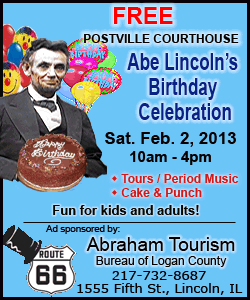 (Copy) (Copy)A public letter/proposal
to current and former residents of Lincoln, Illinois:
Springfield, MO–January 7, 2013: Public statues combined with
historical markers invite and challenge citizens to discover the
stories of local, state, and national history. These stories include
accounts of how sculptors interpret and render their subjects. The
sum of these stories, encompassing social, political, and cultural
history, creates a living heritage that communicates core values and
beliefs, helping to bond diverse social groups and succeeding
generations. For the good of the nation, the American heritage must
thrive locally, where it can strengthen a community's civic pride
and promote its economy through tourist appeal.
New public statues of exemplary Americans add to our heritage,
and for communities whose history has been blessed with the fabled
touch of Abraham Lincoln, the answer to the question of what subject
would be appropriate for new statues is a no-brainer. According to
the Web site of the Abraham Lincoln Heritage Coalition, "Abraham
Lincoln couldn’t be any more connected to a city than Lincoln,
Illinois." This community has the distinction of having been named
for and christened by Abraham Lincoln with watermelon juice in 1853,
five years before the Lincoln-Douglas debates made him famous. Mr.
Lincoln was the lawyer for both the town's founders and the company
owning the railroad that led to the town's establishment. In
addition, Mr. Lincoln had various other legal, political, business,
and social experiences in this community, including the adjacent,
earlier town of Postville, which became part of Lincoln.

Historian Carl Volkmann reports that the United States has about
two hundred original, bronze-coated Lincoln statues (in thirty-four
states); and Illinois has fifty-six of them. Springfield, Illinois,
with nine has the most original, bronze Lincolns, plus various
replicas. Chicago has five original, bronze Lincolns, as does New
Salem; Decatur, four; Bloomington, three. Lincoln, Illinois, has two
original, bronze Lincolns and a third planned for the near future.
Additional Lincoln statues in Lincoln are fabricated with such other
materials as plaster and fiberglass, and the city presently has a
total of six Lincoln statues.
The following plan--obviously an ambitious, long-range
plan--describes four more original, bronze statues of Abraham
Lincoln for future development in his first namesake city. Thus,
with seven original, bronze Lincolns, the first Lincoln namesake
city would be second only to Springfield. Most importantly, the
eleven total statues of Lincoln in Lincoln would depict him in more
capacities than statues in any other city of the world except
Springfield, Illinois--athlete, storyteller, student, circuit-riding
lawyer-politician, community founding lawyer, 1858 Republican Senate
candidate, man of God, citizen reading while striding down the
street, and bearded traveler reading a law book while perched on The
World's Largest Covered Wagon. These renderings range from the
realistic to the mythical and comical.
Unlike the proposed Lincoln statue "as tall as the Statue of
Liberty" discussed a few years ago in Lincoln, Illinois, the statues
proposed here do not involve prohibitive costs. The Lincoln statue
as tall as the Statue of Liberty was estimated to cost forty million
dollars, so that amount would have had to come from outside
corporate sources, but none was found. Rather, the statues proposed
here could be developed as affordable projects, accomplished one at
a time, with local fund raising and distant solicitation through Web
sites, direct email, and social media. These Internet resources make
it possible and economical to seek donations from the many former
residents who are proud to call Lincoln their hometown. The Internet
facilitates collaboration, expanding and strengthening a sense of
community.
This Lincoln community has a proven track record of statue
development. After the Logan County Civil War Soldier Statue
Committee completed its work in 2011, some of its members decided to
form a new committee for the purpose of erecting a statue of Abraham
Lincoln as a politician running for the U.S. Senate in 1858. On
October 16, 1858, Lincoln delivered a two-hour campaign stump speech
on the west side of the Logan County Courthouse in downtown Lincoln.
This speech was the highlight of the "monster" Republican rally--the
day after the last Lincoln-Douglas debate (in Alton). According to
some authorities, Lincoln's Alton performance was one of his best
throughout the campaign. Lincoln's stump speech in his namesake city
the day after the Alton debate most likely was a rousing call to
action, demonstrating his remarkable oratorical power.
[to top of second column] |
 This 1858 rally-speech was one of Abraham Lincoln's most
significant experiences in his many years of appearing in Logan
County, from 1839 to 1860, as a well-respected lawyer, celebrated
storyteller, and venerable politician who helped to found the
Republican Party in Illinois and develop that party at the national
level. In 2007-2008 I proposed a Lincoln statue and historical
marker to commemorate the 1858 rally-speech as part of my
contribution to the Abraham Lincoln Bicentennial Commission of
Lincoln, Illinois. I also proposed a re-enactment of this event,
researched it, and wrote the play script for the re-enactment that
was performed on October 16, 2008, as the main event of the city's
Lincoln Bicentennial Celebration.
When the current Lincoln statue project is completed, another
could be started, continuing the momentum. Here are the proposed
statues: 1. Lincoln the Circuit-Riding Lawyer-Politician,
erected at the Postville Courthouse State Historic Site; 2.
Lincoln the Storyteller, erected across the street from the
Postville Courthouse near the two historical markers for the Deskins
Tavern and Postville community well; 3. Lincoln the Athlete,
erected at the Postville Park near the existing historical marker
that refers to his playing "townball" at this location; 4.
Lincoln the Man of God, erected in the Abraham Lincoln Memorial
Prayer Garden at Lincoln Christian University. This statue was
proposed in the 1970s, but then the plan was forgotten.
The first three statues listed above would be within two blocks
of one another on historic business Route 66 and would call to the
countless tourists who travel it. These statues would be only a few
blocks from the giant fiberglass Abe statue on The World’s
Largest Covered Wagon, also on historic Route 66. These first
three proposed statues would thus strengthen the connection between
the two most-celebrated aspects of this community's
history-heritage: Abraham Lincoln and the Mother Road.
The first and fourth of these proposed statues in Lincoln could
be designed using artwork created by the late Lloyd Ostendorf, a
respected Lincoln historian-collector and talented artist. Several
recent historical markers throughout Lincoln and Logan County
feature Ostendorf colorized artwork. These markers are part of the
county-wide Looking for Lincoln program under the leadership of
professional historian Paul Beaver and Wanda Lee Rohlfs, former
executive director of Main Street Lincoln.
The ongoing process of developing Lincoln statues in Lincoln
could inspire other Logan County communities with historic ties to
Abraham Lincoln to undertake Lincoln statue projects. Those
communities are Atlanta, Elkhart, Middletown, and Mt. Pulaski.
The eleven statues cited here would enable Lincoln, Illinois, to
gain additional prestige as a Lincoln-heritage community--increasing
civic pride and adding tourist appeal. Many tourists are curious
about statues and historical markers. Tourists park and walk to see
them up close. These experiences sometimes spark interest in such
other related sites as museums, and Lincoln is home to the Abraham
Lincoln Heritage Museum at Lincoln College--"One of the 10 best
Lincoln-related sites in Illinois," according to Illinois NOW
magazine. The more time spent at historical attractions, the greater
the likelihood that visitors will patronize shops, eateries, and
motels.

_______
D. Leigh Henson, Professor Emeritus of English, Missouri State
University at Springfield
I have added a Web page to my online community history of Lincoln
to publish this proposed plan, including a photographic essay with
more details about each of the proposed statues. This Web page also
includes information about the Lincoln statue now being developed, a
photographic essay telling about the six existing Lincoln statues in
Lincoln, and links to related resources:
http://findinglincolnillinois.com/
lincolnstatueplan.html.
Feel free to forward a link to this Web page and to print and
distribute copies of it as you wish.
[By D. LEIGH HENSON] |